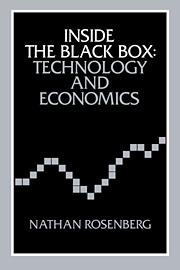Book contents
- Frontmatter
- Contents
- Preface
- Part I Views of technical progress
- Part II Some significant characteristics of technologies
- 3 Technological interdependence in the American economy
- 4 The effects of energy supply characteristics on technology and economic growth
- 5 On technological expectations
- 6 Learning by using
- 7 How exogenous is science?
- Part III Market determinants of technological innovation
- Part IV Technology transfer and leadership: the international context
- Index
6 - Learning by using
Published online by Cambridge University Press: 08 January 2010
- Frontmatter
- Contents
- Preface
- Part I Views of technical progress
- Part II Some significant characteristics of technologies
- 3 Technological interdependence in the American economy
- 4 The effects of energy supply characteristics on technology and economic growth
- 5 On technological expectations
- 6 Learning by using
- 7 How exogenous is science?
- Part III Market determinants of technological innovation
- Part IV Technology transfer and leadership: the international context
- Index
Summary
The assertion that economic activity involves a significant learning dimension would probably command universal agreement. Indeed, at that level of bald and unqualified assertion, there is very little to disagree with. The more interesting questions arise when we attempt to give the assertion some empirical or analytical content.
I will argue that we may fruitfully look upon technological innovation as a learning process–in fact, as several distinct kinds of learning processes. Sometimes, as we will see, these overlap or feed back upon one another. An essential first step, then, is to recognize that several different categories of learning exist. It is important to achieve some conceptual clarity because, as I will argue, there is at least one form of learning in the innovation process that has not been recognized and that is probably of increasing significance in a high-technology economy. This paper should therefore be regarded as part of a larger intellectual enterprise whose purpose is to identify the several different types of learning processes, as well as the nature of these processes and the ways in which they feed into the larger pattern of activities that constitute technological innovation. The main focus is not upon major innovations of Schumpeterian magnitude but, rather, upon the minor improvements that determine the rate of productivity growth that major innovations are capable of generating. In this respect, one main purpose of the paper is to clarify the linkages between technological processes and their economic consequences.
- Type
- Chapter
- Information
- Inside the Black BoxTechnology and Economics, pp. 120 - 140Publisher: Cambridge University PressPrint publication year: 1983
- 9
- Cited by



